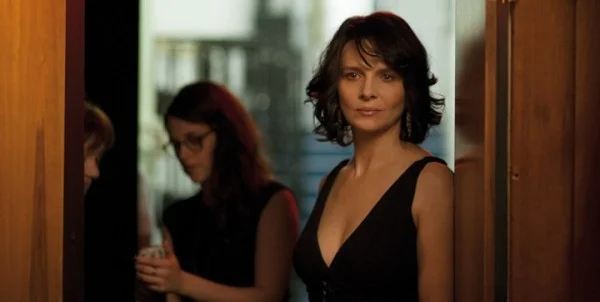TIFF14: Clouds of Sils Maria
Olivier Assayas is a cinephile’s director; his films demonstrate a consciousness of not only the history of cinema, but of film form, which rewards viewers who are particularly interested in the medium itself as a subject. Clouds of Sils Maria, like Assayas’ 1996 film, Irma Vep (his take, of sorts, on Truffaut’s Day for Night) is a film that is about the making of films, but it is also about the way that the making (and watching) of films crafts us as people, shaping our identities and shaping the meaning of our lives.
Clouds of Sils Maria tells the story of an actress named Maria Enders, played by Juliette Binoche, who is enroute to Switzerland with her assistant Val (Kristen Stewart) to accept an award on behalf of the playwright who gave her the role that made her career, both on the stage and in its film adaptation, when she receives news that he has died. The play, Maloja Snake, is about a romance between an older woman Helena, and a younger woman, Sigrid, (Assayas has loosely based the fictional play on Fassbinder’s The Bitter Tears of Petra von Kant). The role of Sigrid made Maria a star, and now years later she is offered the chance to star in a restaging of the play by a London director, but this time in the role of the older Helena.
The bulk of the film plays out as Maria and Val retreat to the mountains in St. Moritz to run the lines for the play, staying in the villa of her deceased playwright friend. Maria has serious misgivings about taking on the role of Helena. Her relationship to the role of Sigrid was a formative one that she deeply connected to, but it is obvious that everyone now sees her as more appropriately playing Helena, a thought which doesn’t give her much comfort. Val encourages her to try to see the humanity and the complexity in Helena, but the casting of the brash young tabloid-baiting, superhero movie starlet, Jo-Ann Ellis (played by Chloë Grace Moretz), in the role of Sigrid prompts Maria and Val to consider the nature of performance and aging and change.
One of the film’s joys is just seeing Binoche and Stewart (who shines in the role of Val) hash out their opinions about acting and aging over drinks, all while hanging out in the Alps and waiting for a glimpse of the rare cloud formation, the “Maloja snake” that gives the film its title. The film relishes the conflations between actor and character, and the way that the audience’s knowledge of Binoche and Stewart’s careers informs that further. For instance, in one scene when Val admits she really admires Jo-Ann for being herself and owning her bad behaviour, Stewart gives off a knowing glee at the fact that a media saturated audience will be comparing Jo-Ann’s career to Stewart’s own Twilight and TMZ exploits.
For me, Assayas is a director who never ceases to excite, because I know that whichever topic he tackles he will bring his unique energy and skill to it, with his fabulous music cues and roving, fluid camera work. He and his cast also clearly had a lot of fun creating some of the tabloid footage of Jo-Ann and part of her performance in a sci-fi superhero flick. In many ways the subject of this film is the star, Binoche, who told us in a Q&A after the film that Assayas wrote the film in a response to her challenge to him to write a film about complex female characters. This adds further layers to the already convoluted web of identity between Maria, her roles as Sigrid and Helena, and Binoche.
For a film that deals with fairly substantive ideas, such as the nature of performance, and the vagaries of aging—especially the ways that age can change who we are—the film has a surprisingly light touch. The great performances and impeccable camera work makes Clouds of Sils Maria incredibly enjoyable to watch and leaves you with plenty to think about as well.
9 out of 10
Clouds of Sils Maria (France/USA)
Written and directed by Olivier Assayas; starring Juliette Binoche, Kristen Stewart, Chloë Grace Moretz, Lars Eidinger.
Clouds of Sils Maria played at the Toronto International Film Festival as part of the Special Presentations programme.
